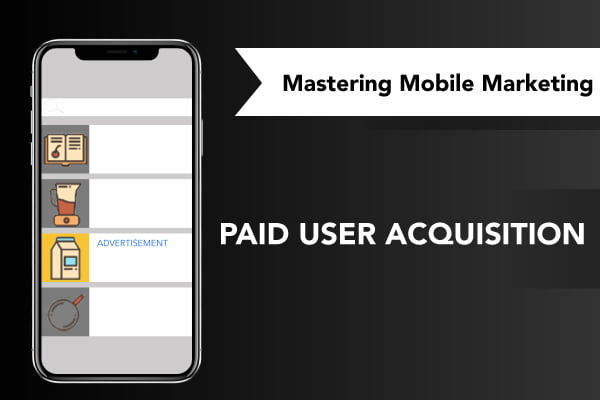In this episode, we are covering the topic of paid user acquisition to give you an idea of what you can gain and how effective it can be in promoting an app. Paid user acquisition is key in the mobile app space and an imperative step towards building a strong user base.
Paid user acquisition: what is it?
Paid user acquisition is the process of mobile app owners paying for mobile placements across social channels, in-app and mobile web. Advertising on mobile can be done through a number of ways. We could use video format, gamified units, native ads and full and mid-page units. It is much more sophisticated than the old-school banners and pop-ups that we are used to.
Here’s a hypothetical situation:
Let’s say I have my very own lifestyle app, tailored around yoga, healthy eating and all things ‘zen.’ I’d like to increase its user base, and be a real contender in its specific vertical space.
So, my app has launched, and is ready to be enjoyed by all, so it is important that I have a paid user acquisition strategy in place. As I mentioned, this is integral in scaling and solidifying your user base and most importantly, it should be part of a wider app marketing strategy. Be sure to check out our videos on app user retention and engagement strategies, this is a key prerequisite before implementing paid user acquisition.
In my case, I need to plan my campaign carefully, with regards to location, audience, device type, campaign length and most importantly, budget.
For my app, I am willing to spend £50,000 this month to acquire for 3,000+ users and for them to complete their first yoga routine. I want to target android and iOS users, in the UK.
Now that I have my budget in place, it is important that I determine my target audience. This is because I want to ensure that I am spending my money on high-intent users, who are most likely going to be of high, long term value. So, in my case, I want to target young professionals and health enthusiasts, between the ages of 18-25. Now the question is…
Where do I find users?
The mobile advertising eco-system is made up of a number of players. We have agencies, DSPs, SSPs, Ad-Networks, location and video partners, premium publishers and social channels for example.
With paid user acquisition, it is vital that we determine the best possible combination of channels to use and how much budget to allocate. For example, certain channels may offer cheaper piad user acquisition costs but offer volume, in comparison to more premium publishers, who have high-intent, niche audiences. Whilst buying programmatically with Ad Networks allows campaigns to scale and widen reach, it is important to strike a balance between acquiring quality users and a high volume of users.
A few things to keep in mind before launching paid user acquisition campaigns:
- Tracking:
Ensure that you have a tracking solution to monitor events, from the point of receiving an ad, to installation, to in-app events, in order to effectively optimise the campaigns and push users through the conversion funnel.
- Fraud:
Unfortunately, fraud in an industry-wide problem that we know exists in the paid user acquisition space. Click fraud and attribution fraud for example, is something that we can monitor and minimise throughout campaigns.
- Creative:
For the fun stuff. Ensure that you creative is tailored and specific to each campaign and suitable to use across your chosen platforms and make sure you understand your creative specifications.
- Testing:
Ensure that you test your campaigns to ensure that your tracking has been implemented correctly.
Make sure to like and subscribe to our YouTube channel, and don’t forget to watch our last video of the series, to find out more about the perfect strategy to launch your app.
Want to find out more about optimising your app and keeping up with the latest OS capabilities? Make sure to subscribe to our Mastering Mobile Marketing video series. You can also get in touch by visiting the Contact Us page. Follow us on LinkedIn, chat with us on Twitter @yodelmobile, and join our #mobilemarketingUK LinkedIn group.










